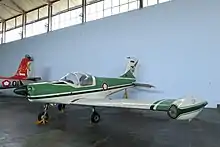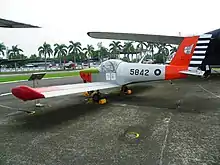Pazmany PL-1
The Pazmany PL-1 Laminar and Pazmany PL-2 are American two-seat trainer and personal light aircraft designed by Ladislao Pazmany to be marketed as a homebuilt aircraft by his company Pazmany Aircraft Corporation. The aircraft was built under license in Taiwan (Republic of China) as the AIDC PL-1B Cheinshou. It was later followed by an improved version the PL-2. The SLAF Aircraft Engineering Wing developed a modified variant of the PL-2 in 1977, which was never used operationally.
| PL-1 Laminar/Cheinshou and PL-2 | |
|---|---|
 | |
| Pazmany PL-2 at Winter Haven Airport, Florida, in 2011 | |
| Role | Two-seat trainer |
| Manufacturer | Pazmany Aircraft Corporation |
| Designer | Ladislao Pazmany |
| First flight | 23 March 1962 |
| Primary users | Republic of China Air Force Indonesian Air Force |
Development
The PL-1 Laminar was the first design by Ladislao Pazmany, it was intended to be marketed for the homebuilt market. The prototype first flew on the 23 March 1962. The PL-1 is a cantilever low-wing monoplane with a fixed tricycle landing gear. It has side-by-side seating for a crew of two and is powered by a 95 hp (71 kW) Continental C-90 piston engine. The Aerospace Industrial Development Corporation (AIDC) acquired plans and built a PL-1 for evaluation with a first flight on 26 October 1968. AIDC then built 58 aircraft designated the PL-1B for the Republic of China Air Force and fitted with a 150 hp (112 kW) Avco Lycoming O-320 engine.
Soon after the first flight Pazmany produced an improved design, the PL-2 which had a slight increase in cockpit width and changes to the structure to make it easier for homebuilders. The PL-2 was evaluated by a number of air forces in South East Asia. It was built under license in Indonesia as the LIPNUR LT-200.
Variants

- PL-1
- Original design for home-built light aircraft
- PL-1B
- License-built variant by AIDC with a 150hp (112kW) Avco Lycoming O-320 engine, 58 built. Known as the PL-1B Chieh Shou.
- PL-2
- More rounded, wider cockpit, increased wing dihedral.[1][2]
- PL-2A
- Improved model, all metal, two seats[3]
- LT-200
- License-built variant by LIPNUR in Indonesia, 4 were built.[4]
Operators

- Indonesian Air Force - LT-200 (Licensed-built PL-2)
- Republic of Vietnam Air Force - One aircraft, no longer in service. Named Tien Phong "Pioneer" and built under U.S supervision. Plans for additional aircraft were cancelled in 1972[5]
- Republic of China Air Force - PL-1, PL-1A, PL-1B
- Republic of China Army - PL-1B
Former Operators
- Sri Lanka Air Force - Sri Lankan built PL-2 variants were in operation until the early 1980s.
- Thai Air Force - Two PL-2 were assembled in 1974 by Thai Air Force. Possibly they were evaluated for production, but no further aircraft were built. One of them is now on display at the RTAF Museum.
Specifications (LT-200)
Data from The Illustrated Encyclopedia of Aircraft (Part Work 1982-1985), 1985, Orbis Publishing, Page 2694
General characteristics
- Crew: 2
- Length: 19 ft 3.5 in (5.88 m)
- Wingspan: 28 ft 0 in (8.53 m)
- Height: 7 ft 7 in (2.31 m)
- Wing area: 116.0 sq ft (10.78 m2)
- Empty weight: 904 lb (410 kg)
- Gross weight: 1,609 lb (730 kg)
- Powerplant: 1 × Avco Lycoming O-320-E2A flat-four piston , 150 hp (112 kW)
Performance
- Maximum speed: 152 mph (245 km/h, 132 kn)
- Endurance: 5 hours 30 minutes
- Service ceiling: 14,995 ft (4,570 m)
References
- Air Trails: 18. Winter 1971.
{{cite journal}}: Missing or empty|title=(help) - Bayerl, Robby; Martin Berkemeier; et al: World Directory of Leisure Aviation 2011-12, page 114. WDLA UK, Lancaster UK, 2011. ISSN 1368-485X
- Tacke, Willi; Marino Boric; et al: World Directory of Light Aviation 2015-16, page 120. Flying Pages Europe SARL, 2015. ISSN 1368-485X
- "Kunjungan Pazmany ke Lipnur". aviahistoria.com (in Indonesian). 6 March 2021. Retrieved 11 March 2021.
- Air Progress. December 1971. p. 77.
{{cite magazine}}: Missing or empty|title=(help)
- The Illustrated Encyclopedia of Aircraft (Part Work 1982-1985), 1985, Orbis Publishing, Page 2694